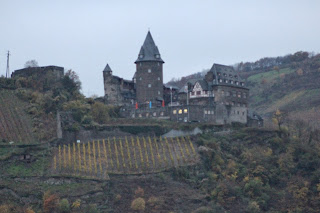We floated down the Main River all night, and went right through Frankfurt. About dawn we heard what we initially thought was another train going by, but when we looked out the window, we discovered we were right in the flight path for Frankfurt airport. Friends we had breakfast with had a similar surprise... when they opened their curtains to check the weather, they found themselves looking at a jumbo jet --a bit disconcerting when you've been cruising down a quiet river.
 |
| entering the Rhine from the Main |
Shortly after breakfast we got to the point where the Main empties into the Rhine. We headed downstream and tied up in Mainz. The city is very old, having been founded by the Romans, who built a wall along the river to defend themselves from the German Vandals on the other side of the river.
 |
| the Iron Tower |
The city was subject to flooding, so in the mid 20th century they created a new wall, extending the city about a block into the river, and raising the level of the town several meters above flood stage. This tower was originally one of several trading gates along the wall. Now you have to cross a busy street and the plaza in front of city hall before you get to the river.
Much of the town was destroyed in WWII. The rebuilding has been a mix of restoring the old and being creative with the new. The building on the right (the Venetian blind look) is one. From this side and inside it is modern, but if you go out to the main square you see a very different look.
 |
| east side of buidling |
 |
| inside |
 |
| the salmon colored building is the south facade |
The cathedral in town celebrated its 1000th anniversary a while back, although the one we saw was not the original building. The first one burned down the day it was scheduled to be consecrated. (Inside it was so dark that they had put too many candles and torches and they caught the roof on fire. It was such a hot fire that the stone walls were damaged.
.JPG)
Inside, the church has some interesting windows... they all are topped with deep blue, red and white stained glass stars.
All around town we could see preparations for the Christmas market. Just behind the cathedral was a cluster of barrels. Our guide pointed out that these are actually places to sit and drink the gluhewein (mulled wine)... romantic little corners to get out of the cold.

The highlight of the tour was a visit to the Gutenberg museum, where not only did we get to see several Gutenberg Bibles, but we got a demonstration on a replica of the original press.
The tour guide even made a piece of movable type as we watched, and one of our shipmates helped to print a page... here she's trying to get the lever to the right point so that a half ton of pressure will push the paper onto the inked type pieces.
Appropriately, outside the building, one of the benches is a stone book, and big wooden type pieces are scattered on the sidewalk.












































.JPG)


.JPG)


.JPG)




.JPG)
.JPG)


.JPG)
